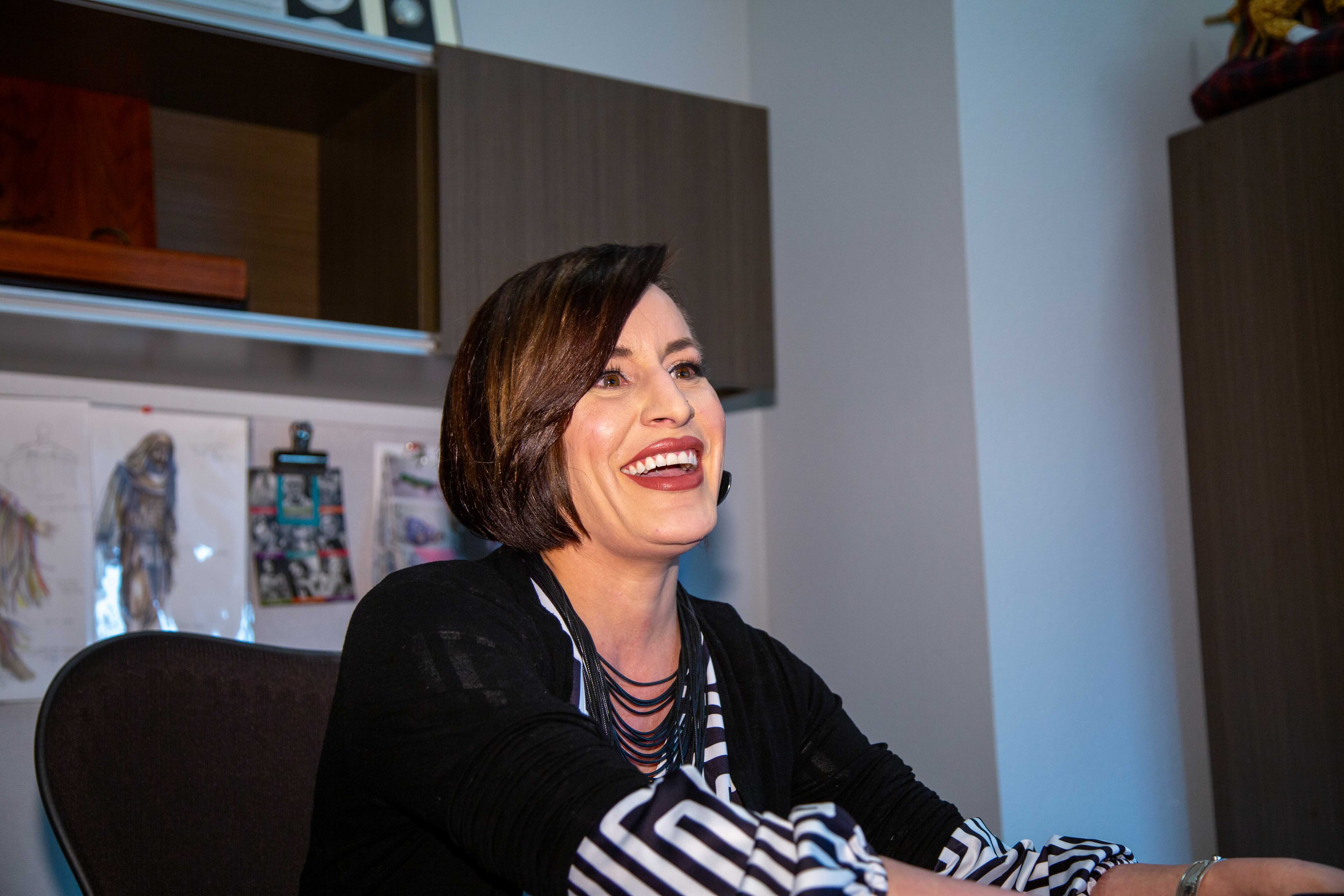
Creating Realities
By Amanda Castro-Crist | Photography by Urvi Dalal
Mallory Prucha wants to do all the things, all the time, with everyone.
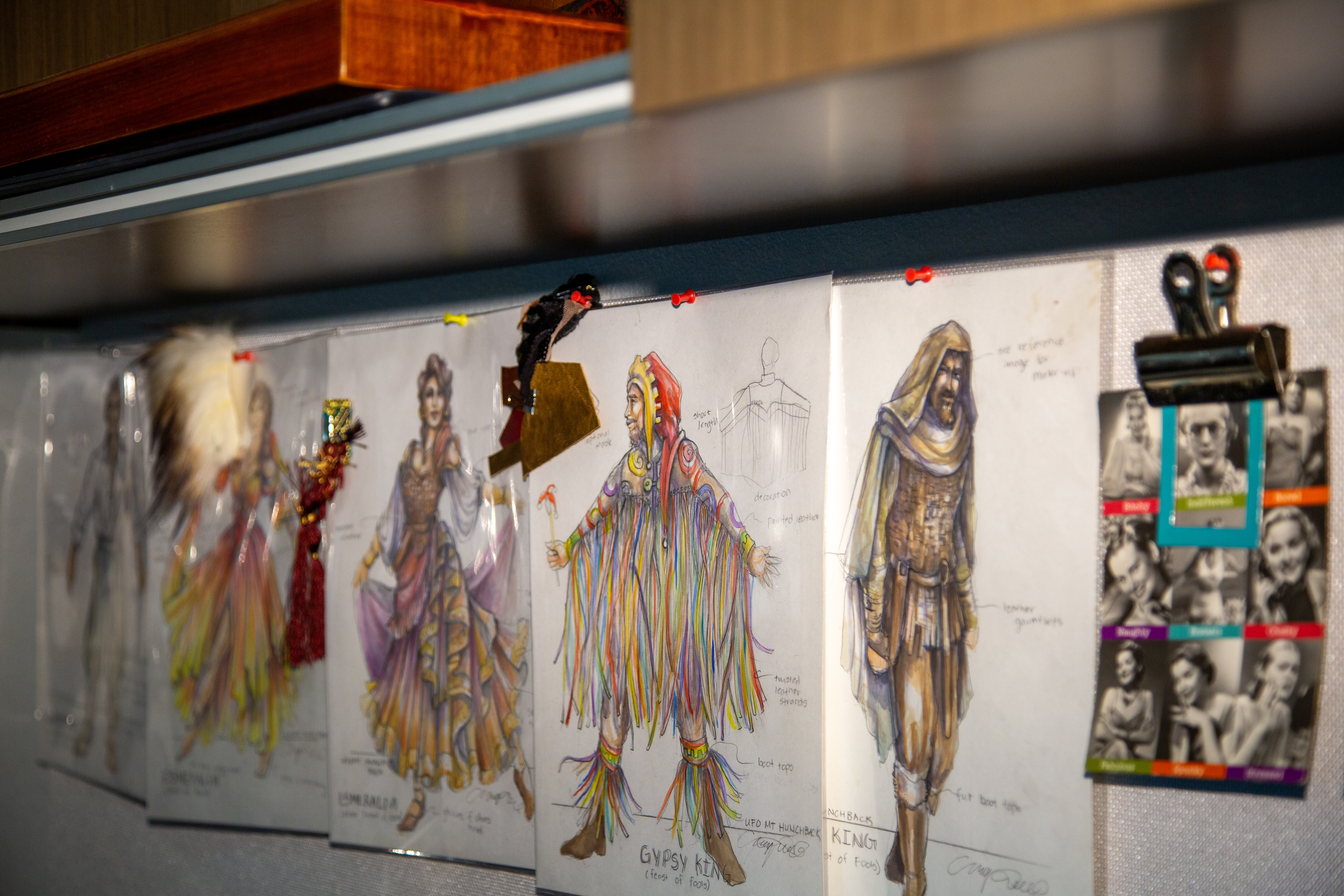
She’s got a pretty good track record. There’s an incredible list of projects under her belt—a belt she very well may have designed and fabricated herself. There’s the sheer number of her collaborators, including her students and colleagues in the J.T. & Margaret Talkington College of Visual & Performing Arts, but also partners like the U.S. Department of Homeland Security, the Texas Rangers and the John F. Kennedy Center for the Performing Arts.
Above all, there is her determination to prove to even the biggest skeptics the tangible, transformative power of art when allowed and encouraged to cross disciplinary lines.
“I’ve been interested in the arts my entire life,” said Prucha, an associate professor in the School of Theatre & Dance. “But I’m also a very curious person. I love the sciences. If there is a problem to solve, those topics interest me, and the arts tend to be a space where I can continue that exploration, and I don’t have to be limited to doing just one thing.”
Arriving in West Texas was a game changer for Prucha. Originally from Nebraska, she found a seemingly blank canvas in Lubbock at the intersection of an institution dedicated to groundbreaking research and a local community devoted to the arts.
At Texas Tech University, she was able to expand her teaching, creative and research efforts, including organizing and coordinating Disaster Day, an annual, multifaceted simulation used to train health care students in real-world, large-scale traumatic events and give students in theater and art a chance to hone their professional creative skills. Now in its sixth year, the event is just one of Prucha’s many examples of the exponential power of collaboration.
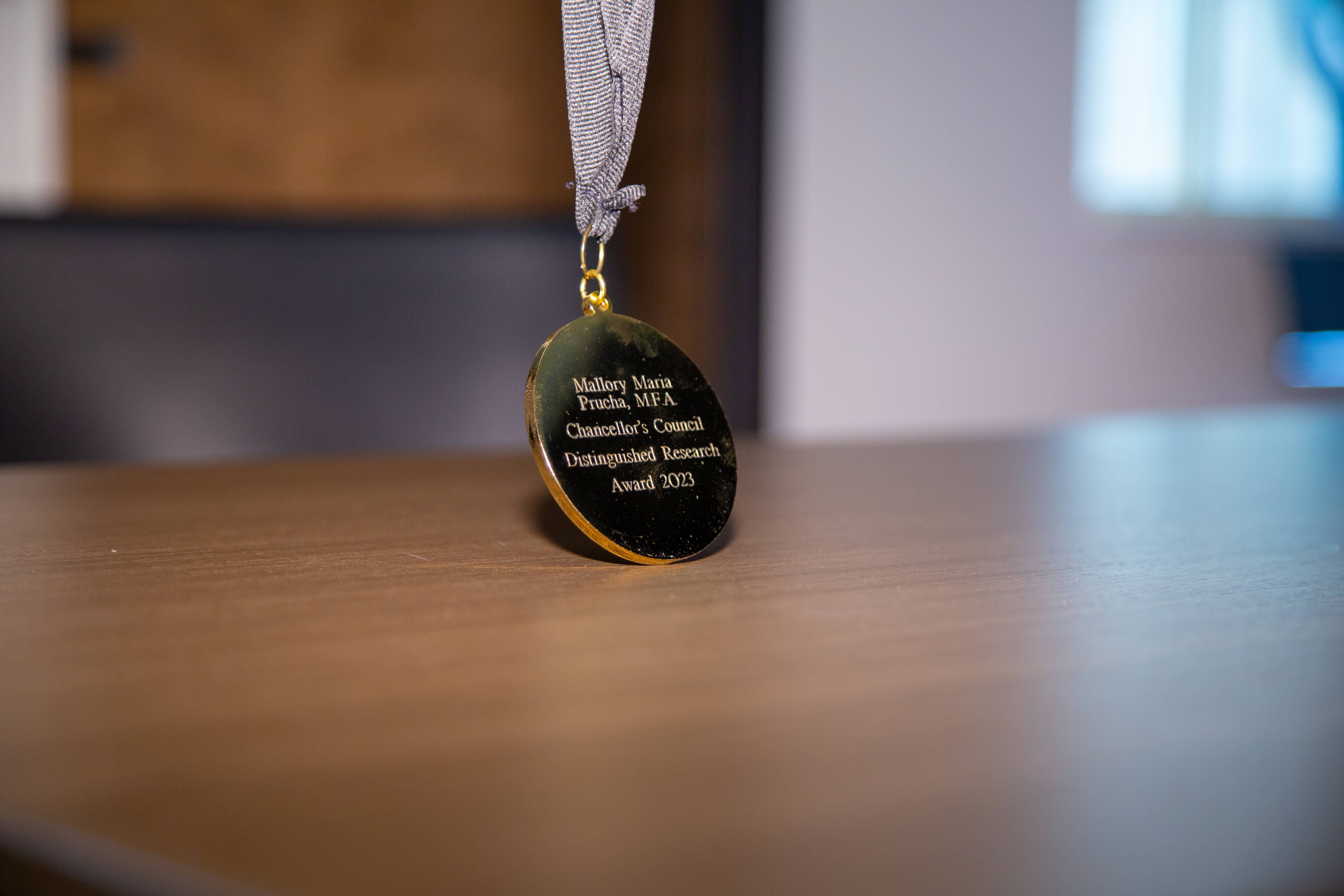
“If you describe my research, it looks like a bunch of unlike parts, but it’s focused on teams and the capacity for what unlike disciplines can do when you work together to create something awesome,” she said. “I’ve been so fortunate to have access to world-class collaborators who appreciate the space and role arts can play in their work. There’s genuine excitement to find ways to ‘interdisciplinize’ and push the arts into the larger STEM environment (known as STEAM) and ask, ‘How is my work making a broader impact? How can it help create a transformative and powerful future for the generations after us?’”
Her efforts to reach across disciplinary lines have paid off in significant ways. Among her recent accolades are the Gold Medallion, one of the highest distinctions awarded in theater education by the Kennedy Center American College Theatre Festival (KCACTF). In 2025, the same year she received the award, KCACTF debuted an updated design of the medallion created by Prucha. She is also the recipient of the Chancellor’s Council Distinguished Research Award, one of the highest honors a Texas Tech University System faculty member can receive. It signifies that the recipient demonstrates research excellence and is an exceptional leader in their field. For Prucha, receiving the award was a humbling experience that ultimately reflects on the environment at the university.
“To see my work recognized as having institutional merit seemed almost impossible elsewhere,” she said. “I couldn’t help but pause and think about the even larger group of people, the love they pour into their work and the many kinds of research that have to come together alongside mine.”
Being honored in this way has provided unexpected benefits, including the opportunity to advocate for ideas that once might have seemed too ambitious or extraordinary.
“It’s been wonderful to be a champion for colleagues from many different institutions who are part of the arts,” Prucha said. “It is an opportunity to help inspire others to see their greatness. And it hasn’t hurt when it comes to saying that I know what I’m talking about. They gave me a medal. I’m not just a bag of strange ideas in the corner.’”
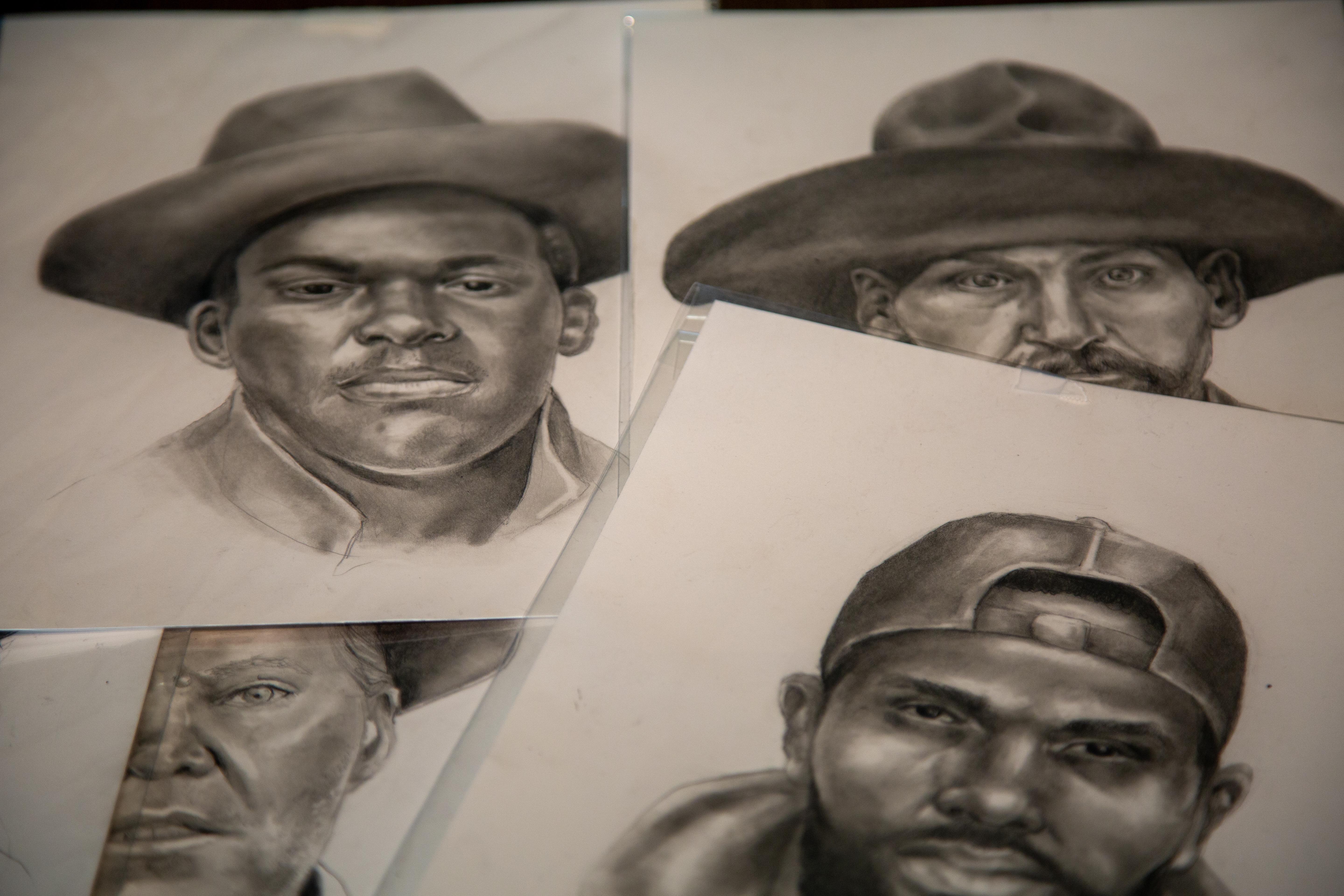
It’s also allowed her to expand the opportunities she provides to her students that will best position them for future success.
“Applied arts and social practice are integral and central to the work I do in the classroom,” Prucha said. “I can teach theory and all sorts of more esoteric things, but it’s not until students come into contact with an audience, or the tools, that they really understand what they are doing and the real-life challenges that come with it. Those are things that can translate to job readiness skills.”
Prucha doesn’t plan on slowing down. There’s still so much she wants to do.
In one of her wildest dreams, she and her collaborators are gifted a corner of the local Air Force base, which they transform into a comprehensive simulation environment, taking Disaster Day to a whole new level. She also hopes to one day participate in a fellowship at CERN in Switzerland called “Collide.”
“This award just turned the volume up on possibility in terms of being seen, and that sense of additional reinforcement helps empower the work,” Prucha said. “Now, I present ideas like this in a meeting, and someone’s not just going, ‘Oh, there’s Mallory and her weird ideas again.’ They’re going, ‘We should listen.’”
Disaster Day: Where Art & Medicine Collide
There’s smoke on the horizon as students from the J.T. & Margaret Talkington College of Visual & Performing Arts (TCVPA) drive up to the School of Veterinary Medicine in Amarillo. For days, wildfires have burned throughout the Texas Panhandle, affecting people, animals and livelihoods across the area.
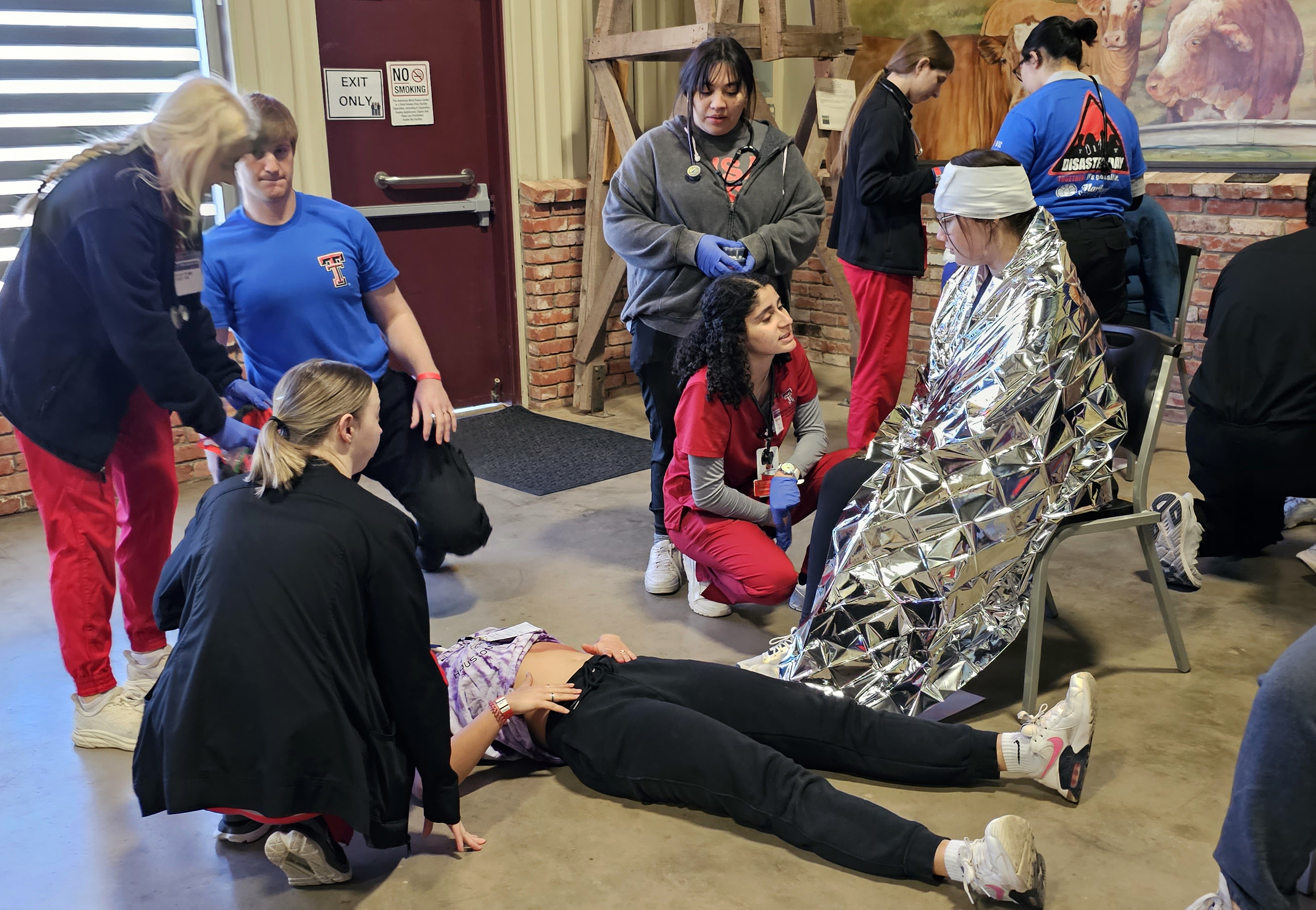 Photo courtesy of Mallory Prucha
Photo courtesy of Mallory Prucha“I was standing outside the Vet School when my students arrived, and they go, ‘Oh, THIS is why we’re doing Disaster Day,’” Prucha said, referring to the annual disaster simulation event led by Texas Tech University Health Sciences Center’s Office of Interprofessional Education (OIPE) and in partnership with TCVPA. “Those are the types of moments that anybody who teaches wants to be part of.”
Wildfires have become more common in the Panhandle in recent years. In 2024, the region endured an outbreak of fires that included the Smokehouse Creek Fire. With more than 1.2 million acres burned, it is the largest wildfire in Texas history. Tornadoes, while less frequent, can also unexpectedly ravage the surrounding communities.
When a catastrophe like this occurs, research has shown it’s imperative that first responders and health care professionals have been properly trained, not just in methods of healing but also in how they react during a disaster. They have to be able to think critically under pressure and consider how they will treat patients with limited resources, technology and support.
“Report after report from FEMA for natural disasters says that the number one reason for poor outcomes was a lack of communication and teamwork,” said Renee Bogschutz, associate provost in OPIE. “You can’t learn to communicate in that moment of disaster because it’s so chaotic. You have to have the muscle memory for those teamwork and communication skills so that when you need them, you already know how to do that.”
Disaster Day is a systemwide effort to help students build those skills. Created several years ago, the annual event brings together students, faculty and staff from Texas Tech University Health Sciences Center (TTUHSC) and TCVPA in a multidisciplinary, collaborative approach to learning and service.
“You might not think these go together, but it shows that we have creative ways to help teach, learn and grow,” said Emily Swenskie, who received her master’s degree in fine arts (MFA) from Texas Tech University (TTU) and now serves as the health care simulation educator in the College of Nursing at the University of Arkansas for Medical Sciences (UAMS). “It’s a beautiful thing to be able to marry the two and to be able to use different aspects from both to really help impact the community. Mallory does a beautiful job of bringing together those interdisciplinary groups.”
During the event, some theater students act as patients, receiving a backstory that includes notes about their current injuries and additional information about any other factors that could affect the care they receive. Substance abuse, domestic violence, homelessness, chronic illnesses: it’s all in the file. Trained as standardized patients, these actors portray the details from their files as a real patient would act.
Another group of theater students put their costume and makeup skills to use, creating moulage –lifelike wounds applied with makeup – and damaged clothing that fit the type of disaster being portrayed. Once the actors are in character, they position themselves throughout the triage area, in chairs and on beds, against walls and on floors, waiting to be treated for their various ailments.
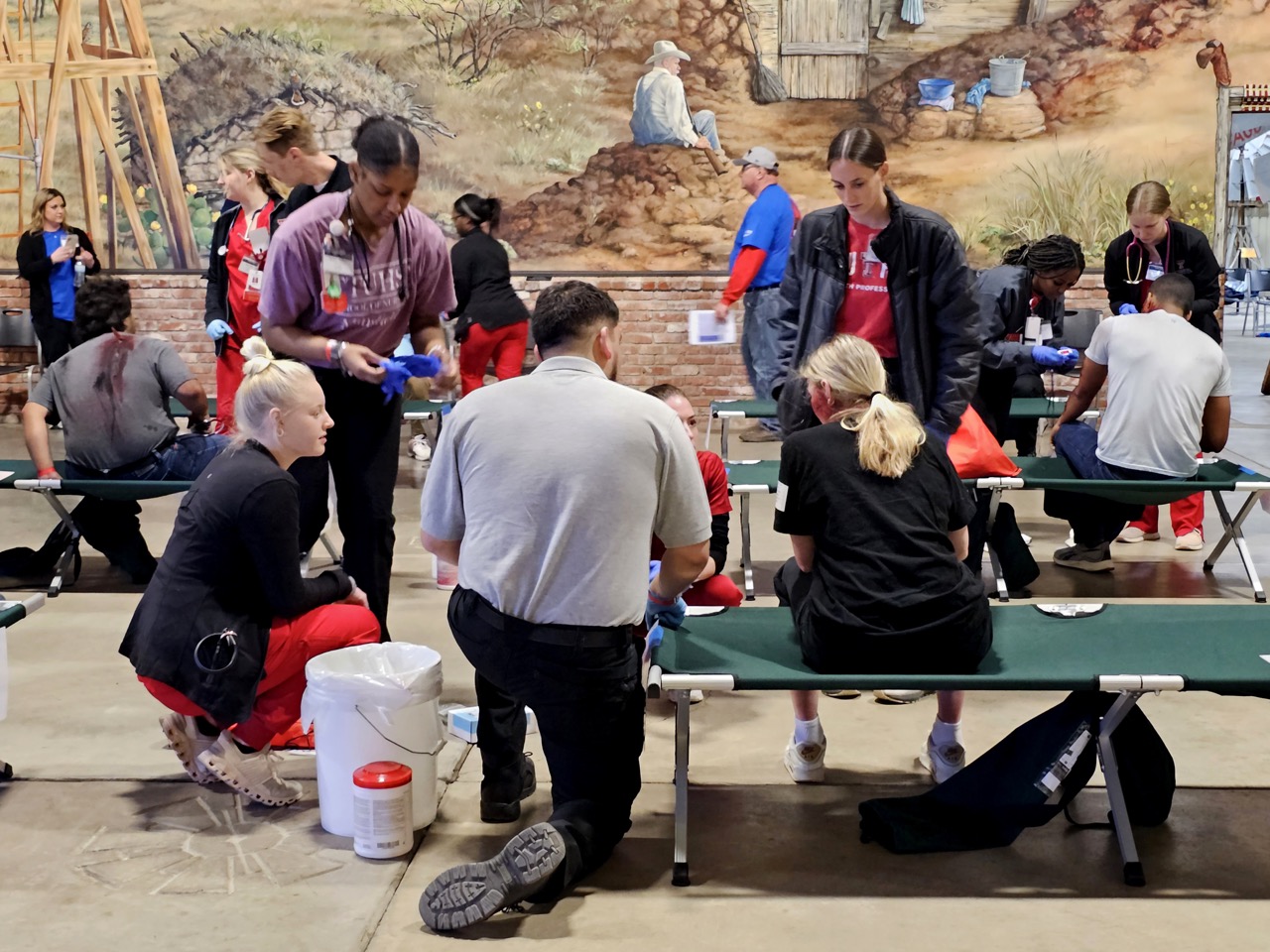 Photo courtesy of Mallory Prucha
Photo courtesy of Mallory PruchaPrucha said the experience of Disaster Day complements students’ work in the classroom. While the latter is essential, it’s not until students can apply what they’ve learned in a real-life setting that they truly understand and develop job readiness skills for the ever-evolving entertainment industry.
“I’m trying to think about what my students need to be able to adapt to an environment that’s changing even quicker than I can keep up with,” Prucha said. “The more I can focus their attention on the possibilities and alternate applications, the more versatile they become. Part of my partnership with the Office of Interprofessional Education at TTUHSC includes training my actors to adapt to their simulation environment and opening their eyes to the fact that it’s not just Broadway, it’s not just touring companies, but there are a variety of things they can pursue. We’re broadening the idea of what success means together. The field of simulation-based training is burgeoning and boasts endless applications across disciplines.”
Once the scene is set and the actors are in place, more students arrive, this time health care students from TTUHSC. They will assess the victims of the simulated disaster and decide on the type of treatment needed and any additional resources that could be beneficial to their recovery.
“In West Texas, it’s not really ‘if’ a natural or man-made disaster will happen, but ‘when,’” Bogschutz said. “Our students are trained really well in disease-specific responses, but they don’t get a lot of training when it comes to disasters. We wanted them to be immersed in the environment, so we partnered with Mallory to do the staging and makeup and train her students on how to act consistently and accurately so our students could respond authentically.”
For some students, the only patients they’ve treated are mannequins in the university’s simulation labs. This will be their first time working with a patient who can respond to questions and provide a true understanding of what it’s like to work with an actual person, Prucha said, adding that the experience will prepare them for scenarios they’ll ultimately face in the workplace.
“The human element is critical. Our actors are skilled in terms of maintaining character, understanding narrative, and bringing something more to it,” Prucha said. “As a health care professional, how do you meet the person where they are? How do you give them not just patient-centered care, but care that is deeply empathetic and helps in some way that’s even more impactful than just triage? If we can make all of these things lifelike in advance, if I give you the fake version with the cherry-flavored blood now, the guesswork will be taken out later. Now you know how to handle it.”
April Langehennig, who participated in Disaster Day before graduating from TTU with an MFA, said the simulations also give health care students the opportunity to brainstorm workarounds for common challenges during a disaster.
“When you’re in a situation like a tornado, you’re not going to have the full medical workups of these people,” Langehennig said. “The internet goes down, cell towers go down. You might have electricity from your generators, but you most likely won’t have access to the normal computer setup where you can look people up. If the person is not fully aware because of being injured, they might not be able to fill in all the blanks that you really need to have quick and easy triage.”
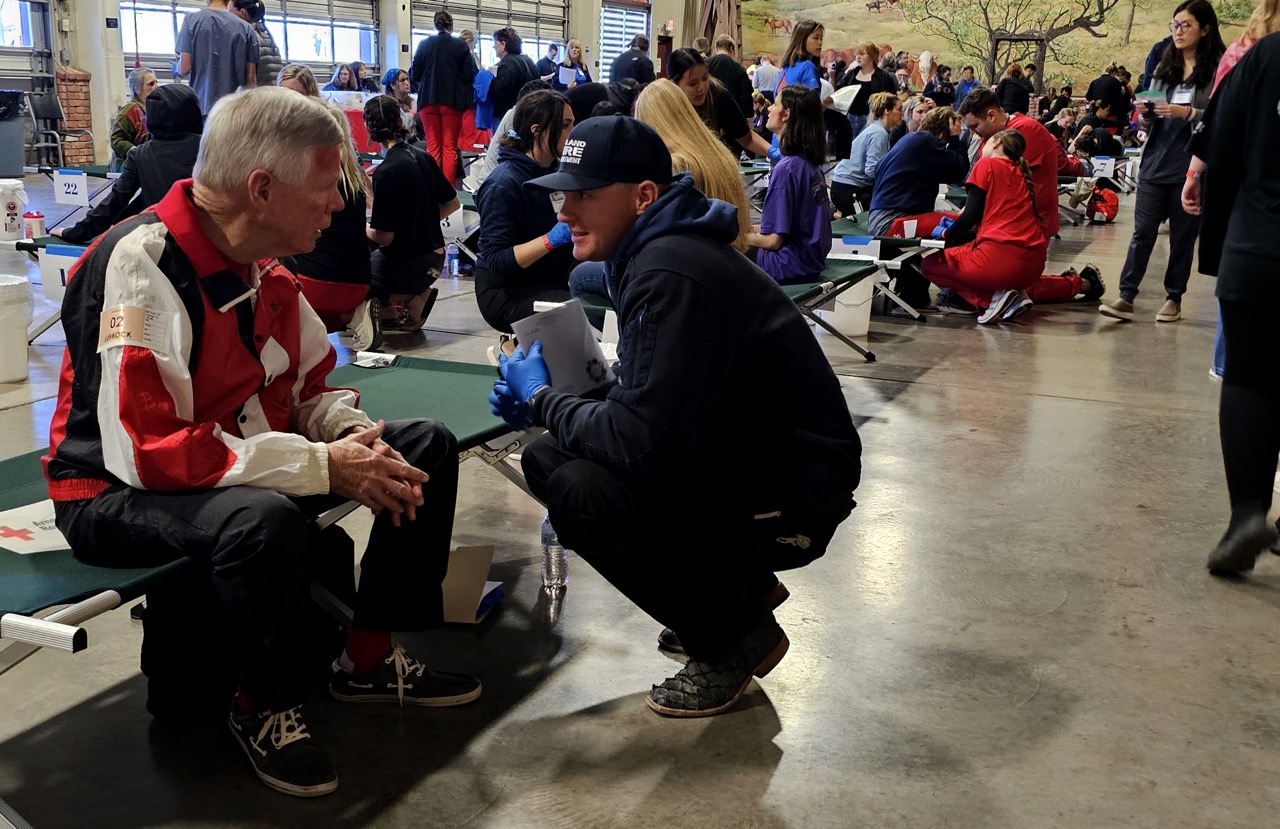 Photo courtesy of Mallory Prucha
Photo courtesy of Mallory PruchaOver the years, the collaborative effort between TTUHSC and Prucha has grown to include even more partners, like local hospitals, city officials and first responders like EMTs and firefighters in Lubbock and Amarillo. Bogschutz said the additional partnerships have allowed them to expand the training to include students from other institutions and organizations.
“We have so many community partners now that students can have an EMS student or a fire academy student on their team,” Bogschutz said. “They learn what the first responders do, and the first responders learn what they do. So not only are they learning how to be a team, they’re learning how to communicate with other teams.”
For the Disaster Day wildfire simulation in Amarillo, a new twist has been introduced: standardized patients are accompanied by animals that play the part of pets and livestock injured in a wildfire. While the animals are fake, students from the School of Veterinary Medicine now get to test their disaster response skills alongside their peers, evaluating the animal victims and choosing a course of treatment.
Bogschutz said the growth and expansion of OIPE's efforts related to Disaster Day speak to how systemwide collaboration can positively impact not just the students involved but the people and communities served by the universities. She said, for this, Prucha is more than deserving of the recognition she has received as a Distinguished Research Award Winner.
“It’s a prime example of how system institutions can work together to better the health of West Texas,” Bogschutz said. “Mallory is such a huge champion for this type of work. She’s knowledgeable, prepared and reliable. We’re so honored and happy to have this relationship with her and her college, and we’re so happy that she received this award. I hope the donors understand the significant impact this has on hundreds and hundreds of future health care professionals in the region.”
Everyone involved, from the learners to the facilitators to the standardized patents, is asked to evaluate the experience after the event. The feedback from those involved is overwhelmingly positive.
“Across all our events, it’s one of the favorites,” Bogshutz said. “They have to work as a team to take care of this mass amount of patients, and Mallory provides such a great, authentic learning environment. One of the things we have to remind them sometimes is that it’s not real. They get so immersed that they almost forget that it’s a simulation because they’re so into it. They love it, and they learn so much from it.”
An incredible amount of coordination goes into making sure Disaster Day happens every year. Michelle Kiser, the associate managing director of OPIE, said it all comes down to Prucha.
“You see a very wide range of items, activities and things that she must have for an event to work,” Kiser said. “You’re talking about making sure that you have what you need to do the moulage appropriately for the different types of disasters and her ability to communicate effectively with those students. She’s always willing to go the extra mile to ensure things get done. She goes above and beyond what is expected of her. She wants to make sure it’s perfect, but she knows that sometimes it’s not always going to be perfect, and she prepares for that, too. She makes it happen. She is that person.”
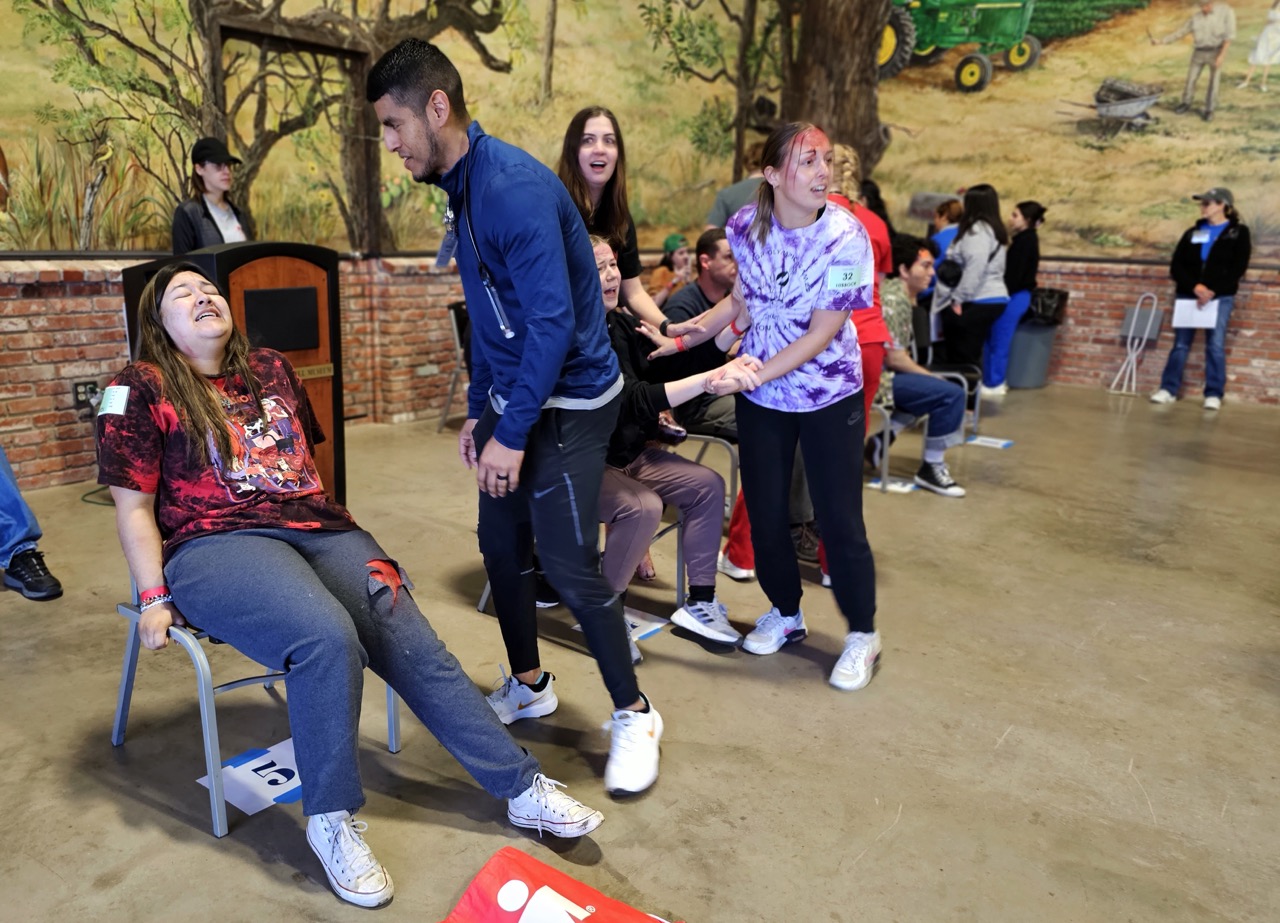 Photo courtesy of Mallory Prucha
Photo courtesy of Mallory PruchaFor Prucha’s students, that passion and dedication are apparent in all aspects of her work, not just Disaster Day. Langehennig, formerly an associate professor of theatre at Howard College in Big Spring, said she has tried to emulate Prucha’s teaching and engagement style in her own classroom. Her students have also had a chance to be part of Disaster Day. As she transitions to her new role at South Plains College, she intends to do the same.
“Of course, I’m going to trust my students with her, because I know she is going to treat everyone the same even while she’s in a stressful situation,” Langehennig said. “Having her as an instructor was amazing because she has such a vast knowledge and tremendous skill. She has extreme talent from the work that she has done and the years of experience, and something that she absolutely excels at is really paying attention to each and every student she has.”
At UAMS, Swenskie now hires and trains standardized patients for the College of Nursing, a role she was able to help build based on her work on Disaster Day and her own pre-graduate work in nursing. She also writes case files and facilitates simulations for the college. She credits the support Prucha gave her while at TTU for how far she’s come since graduation.
“Mallory really fostered my excitement and passion for using theater and theatrics in the health care system and that love and enjoyment for simulations and standardized patients,” Swenskie said. “You walk into her classroom, and she makes it fun with her personality, her giddiness and her overall love for whatever it is she’s doing. When I got this position, she was one of the first people I told, and she was so excited for me. I fully believe that I wouldn’t be where I am and be as successful as I am without her guidance, passion and love for the art of theater and the craft.”
For Prucha, it all comes down to highlighting the potential that exists in each person – and having fun while doing it.
“It’s helping others to realize the deep, deep value – I always call it the undercover superpowers – they have, specifically in terms of problem-solving, time management and collaborative skills,” Prucha said. “We have to remind ourselves that every opportunity is a chance to make something better and that you can have fun in the process. I hope that’s the core of the impact that this body of work accomplishes.”

